2019 MERCEDES-BENZ CLA COUPE flat tire
[x] Cancel search: flat tirePage 295 of 330
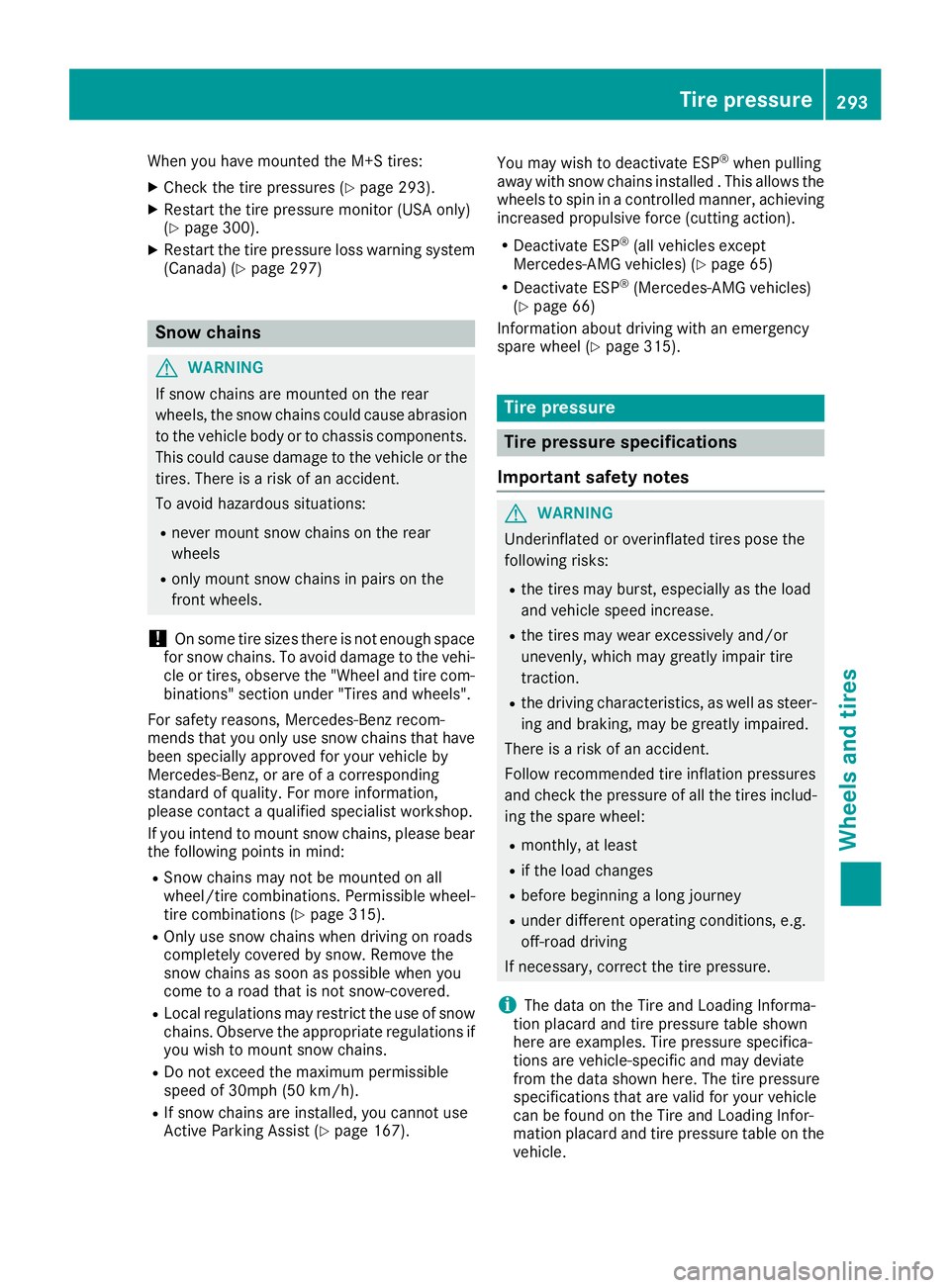
When
youhave mount edthe M+S tires:
X Check thetire pressures (Ypage 293).
X Restart thetire pressure monitor(USA only)
(Y page 300).
X Restart thetire pressure losswarning system
(Canada) (Ypage 297) Snow
chains G
WARNIN
G
If snow chains aremount edon the rear
wheels, thesnow chains couldcause abrasion
to the vehicle bodyortochassis compon ents.
This could cause damage tothe vehicle orthe
tires. There isarisk ofan accident .
To avoid hazardous situations:
R never mount snowchains onthe rear
wheels
R only mount snowchains inpairs onthe
fron twheels.
! On
some tiresizes there isnot enough space
for snow chains. Toavoid damage tothe vehi-
cle ortires, observe the"Wheel andtirecom-
bination s"sect ionunder "Tiresandwheels".
For safety reasons, Mercedes- Benzrecom-
mends thatyouonly usesnow chains thathave
been specially approved foryour vehicle by
Mercedes- Benz,or are ofacorr esponding
standard ofquality. Formore inform ation,
please contactaqualified specialist workshop.
If you inten dto mount snowchains, pleasebear
the following pointsinmind:
R Sno wchains maynotbemount edon all
wheel/tire combinations.Permissible wheel-
tire combin ations(Ypage 315).
R Only usesnow chains whendriving onroads
complet elycovered bysnow. Remove the
snow chains assoon aspossible whenyou
come toaroad thatisnot snow-c overed.
R Local regulations mayrestr ictthe use ofsnow
chains. Observe theappropriate regulationsif
you wish tomount snowchains.
R Do not exceed themaximum permissible
speed of30mph (50km/ h).
R Ifsnow chains areinstalled, youcann otuse
Act ive Parking Assist(Ypage 167). You
may wish todeactivat eES P®
when pulling
away withsnow chains installed .This allows the
wheels tospin inacont rolled manner,achieving
incr eased propulsive force(cutt ingaction ).
R Deact ivateESP®
(all vehicles except
Mercedes- AMGvehicles) (Ypage 65)
R Deact ivateESP®
(Mercedes- AMGvehicles)
(Y page 66)
Inf ormation aboutdriving withanemergen cy
spare wheel (Ypage 315). Tir
epr essure Tir
epr essure specifications
Impor tantsafety notes G
WARNIN
G
Underin flatedoroverinf latedtirespose the
following risks:
R the tires mayburst, especially asthe load
and vehicle speedincrease.
R the tires maywear exces sively and/or
unevenly, whichmaygreatly impairtire
trac tion.
R the driving charact eristics,as well assteer-
ing and braking, maybegreatly impaired.
There isarisk ofan accident .
Follow recomm endedtireinflation pressures
and check thepressure ofall the tires includ-
ing the spare wheel:
R mont hly,atleast
R ifthe load changes
R before beginnin galong journ ey
R under differen toperating conditions,e.g.
off- road driving
If neces sary,correctthe tire pressure.
i The
data onthe Tire andLoading Informa-
tion placard andtirepressure tableshown
here areexamples. Tirepressure specifica-
tions arevehicle-s pecificandmay deviate
from thedata shown here.Thetirepressure
specificat ionsthatarevalid foryour vehicle
can befound onthe Tire andLoading Infor-
mation placard andtirepressure tableonthe
vehicle. Tir
epr essure
293Wheelsandtires Z
Page 297 of 330
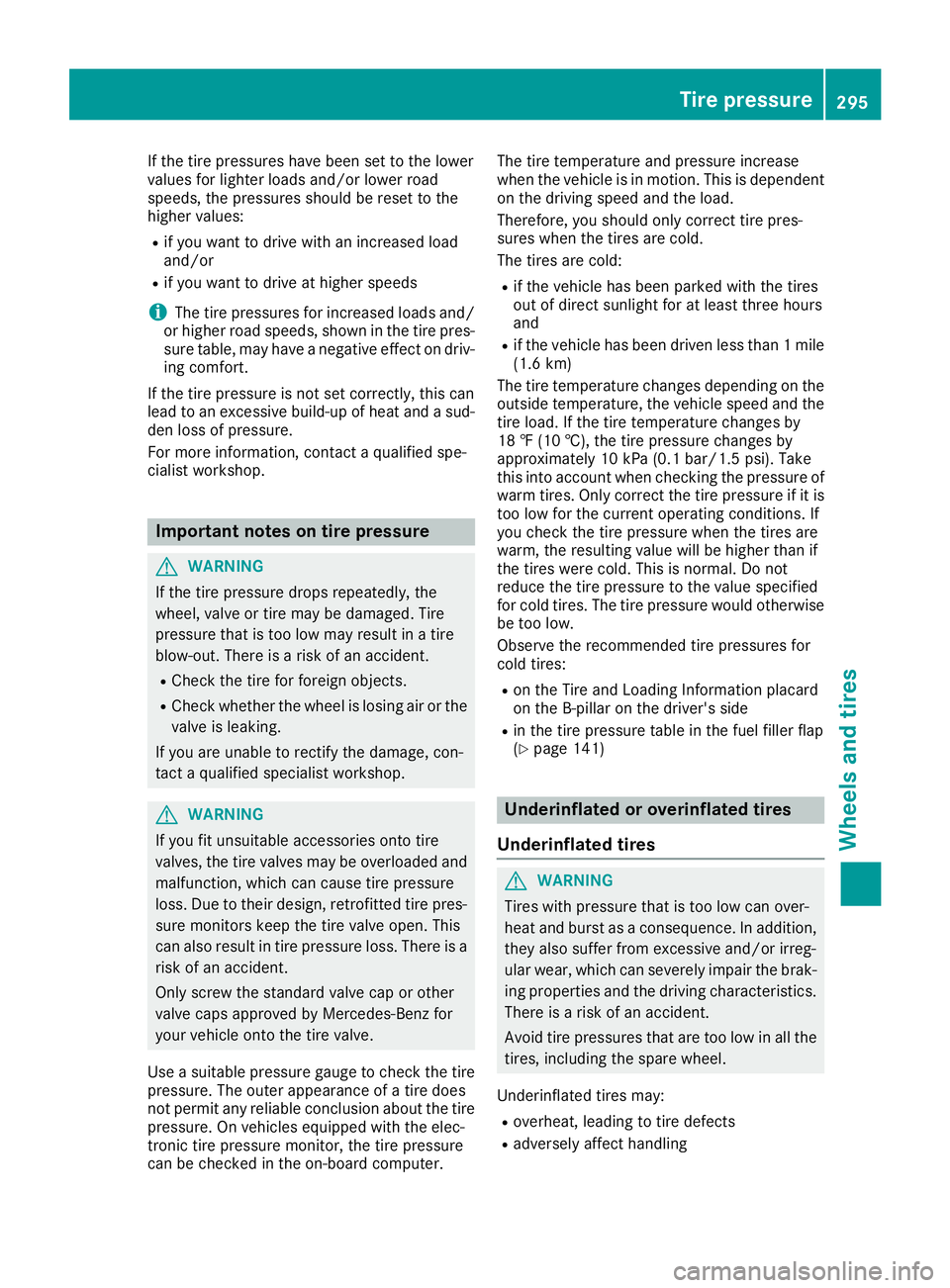
If
the tire pressu reshave been settothe lowe r
valu esfor lighter loadsand/or lowerroad
speed s,the pressu resshoul dbe reset tothe
higher values:
R ifyou want todrive withanincreased load
and/or
R ifyou want todrive athigher speeds
i The
tirepressu resforincreased loadsand/
or higher roadspeed s,shown inthe tire pres-
sure table, mayhave anegative effectondriv-
ing comfort.
If the tire pressu reisnot setcorrectly, thiscan
lea dto an excessive build-up ofheat andasud-
den loss ofpressu re.
For more information, contactaqua lifiedspe-
ciali stworkshop. Important
notesontire pressure G
WARNING
If the tire pressu redrops repeatedly,the
wheel ,valve ortire may bedama ged.Tire
pressu rethat istoo low may resul tin atire
blow -out. There isarisk ofan accident.
R Check thetire forforeign objects.
R Check whether thewheel islosing airorthe
valve islea king.
If you areunabl eto rectify thedama ge,con-
tact aqua lifiedspecia listworkshop. G
WARNING
If you fitunsui table accessorie sonto tire
valves ,the tire valves maybeoverloa dedand
malfu nction, whichcancause tirepressu re
loss. Duetotheir desig n,retrofitted tirepres-
sure monitors keepthetire valve open. This
can also resul tin tire pressu reloss. There isa
risk ofan accident.
Only screw thestandard valvecaporother
valve capsappro vedbyMercedes-Benz for
you rvehicle ontothetire valve.
Use asuita blepressu regau getocheck thetire
pressu re.The outer appearance ofatire does
not permit anyrelia bleconclusion aboutthe tire
pressu re.On vehicle sequi pped withtheelec-
tronic tirepressu remonitor, thetire pressu re
can bechecked inthe on-board computer. The
tiretemperature andpressu reincrease
when thevehicle isin motion. Thisisdepende nt
on the driving speedandtheload .
Therefore, youshoul donly correct tirepres-
sures whenthetires arecold.
The tires arecold:
R ifthe vehicle hasbeen parked withthetires
out ofdirect sunlightfor atlea stthree hours
and
R ifthe vehicle hasbeen driven lessthan 1mile
(1.6 km)
The tiretemperature changesdependingon the
outsid etemperature ,the vehicle speedandthe
tire load .If the tire temperature changesby
18 ‡(10 †), thetire pressu rechanges by
appro ximately 10kPa (0.1 bar/ 1.5psi).Take
this into account whenchecking thepressu reof
warm tires.Onlycorrect thetire pressu reifit is
too low forthe current operatingconditions. If
you check thetire pressu rewhen thetires are
warm, theresul tingvaluewil lbe highe rthan if
the tires were cold.Thisisnormal. Donot
reduce thetire pressu reto the valu especifie d
for cold tires. Thetirepressu rewou ldotherwise
be too low.
Observe therecommended tirepressu resfor
cold tires:
R on the Tire andLoadi ngInformation placard
on the B-pilla ron the driver's side
R in the tire pressu retable inthe fuel fillerflap
(Y page 141) Underinfl
atedoroverin flated tires
Underinfl atedtires G
WARNING
Tires withpressu rethat istoo low can over-
heat andburst asaconsequence. Inaddi tion,
they alsosuffer fromexcessive and/orirreg-
ula rwea r,which canseverel yimpa irthe brak-
ing propertie sand thedriving characteristics.
There isarisk ofan accident.
Avoid tirepressu resthat aretoo low inall the
tires, includi ngthe spare wheel.
Underinfla tedtires may:
R overhea t,lea ding totire defects
R adverse lyaffect handling Tire
pressure
295Wheelsand tires Z
Page 298 of 330
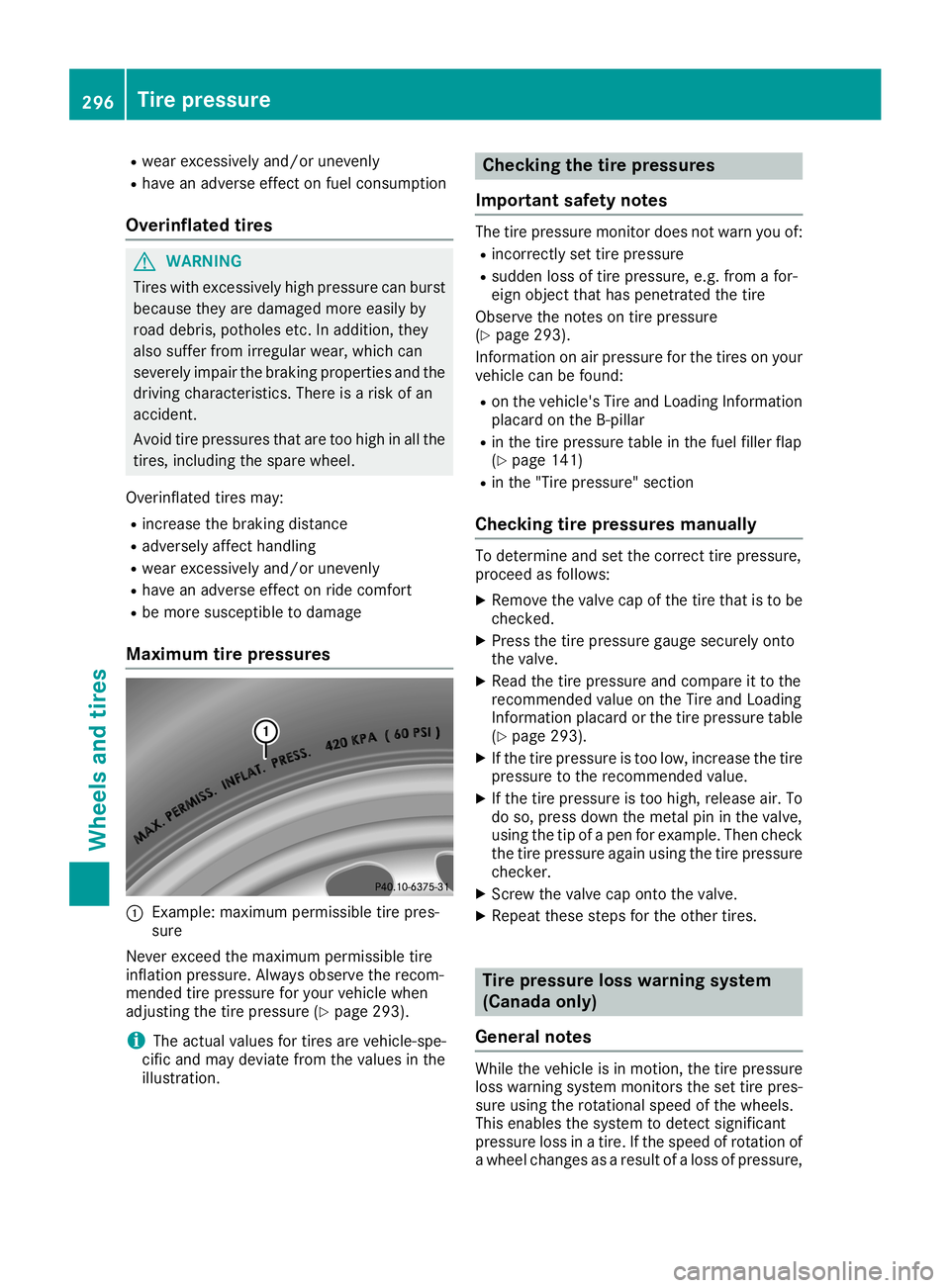
R
wear excessiv elyand/ orunev enly
R have anadver seeffect onfuel consumpt ion
Over inflatedtires G
WAR
NING
Tires withexcessiv elyhigh pressure canburst
becaus eth ey are damaged moreeasily by
road debris ,pot holes etc.In addit ion,they
also sufferfro mirre gular wear, which can
seve relyimpair thebrak ingprope rties and the
driv ingchar acterist ics.Ther eis arisk ofan
acc iden t.
Av oid tirepres sures that are too high inall the
tir es, including thespare wheel.
Over inflated tires may:
R inc rease thebrak ingdist ance
R adver selyaffecthand ling
R wear excessiv elyand/ orunev enly
R have anadver seeffect onride comfort
R be mor esusc eptible todamage
Max imumtirepr essur es 0043
Example: maximum permissible tirepres -
sure
Nev erexc eed themax imum permissible tire
inf latio npres sure. Always observetherec om-
men dedtirepres sure foryour vehic lewhen
adjus tingth etir epres sure (Ypage 293).
i The
actual values fortires are vehic le-spe-
cif icand may deviat efro mthevalues inthe
illust ration. Checking
thetir epr essur es
Imp ortant safety notes The
tirepres sure monitordoes notwarn youof:
R inc orrect lyset tirepres sure
R sudden lossoftirepres sure, e.g.fro mafor -
eign object that has penetrated thetir e
Obser vethenot eson tirepres sure
(Y page 293).
In for mat iononair pres sure forthetir es on your
vehic lecan befoun d:
R on thevehic le'sTire andLoadin gIn for mat ion
placar don theB- pillar
R in thetir epres sure table inthefuel filler flap
(Y page 141)
R in the"Tire pressure" section
Checking tirepr essur esma nua lly To
det erm ineand setthecor recttir epres sure,
proc eedasfollo ws:
X Remov eth evalve capofthetir eth at isto be
che cked.
X Pres sth etir epres sure gauge securely onto
th evalve .
X Read thetir epres sure andcompare itto the
rec omm endedvalue ontheTire andLoadin g
In for mat ionplacar dor thetir epres sure table
(Y page 293).
X Ifth etir epres sure istoo low, increase thetir e
pres sure totherec omm endedvalue.
X Ifth etir epres sure istoo high, releas eair. To
do so, pres sdown themet alpin inthevalve ,
using thetip ofapen forexam ple.Then check
th etir epres sure again usingthetir epres sure
che cker.
X Sc rew thevalve capontoth evalve .
X Repeat these steps fortheoth ertires. Tir
epr essur eloss warning system
(Cana daonly)
Gener alnotes While
thevehic leisin mot ion, thetir epres sure
loss warn ingsyst emmon itorstheset tirepres -
sure using therot ation alspeed ofthewheels.
This enabl esthesyst emtodet ect sign ificant
pres sure lossinatir e. Ifth espeed ofrot ation of
a wheel changesasaresult ofaloss ofpres sure, 296
Tir
epr essur eWheels andtires
Page 299 of 330

a
cor respon dingwarn ingmes sage willappear in
th emult ifunction display.
You canrecogn izethetir epres sure losswarn ing
by theRun FlatInd icator Active Press Run
FlatInd icator Active Press
'OK ' 'OK
'to to
Res tart Res
tartmes sage inthemult ifunction
display intheSer v. Ser
v.men u.Infor mat iononthe
mes sage display canbefoun din the"Rest arting
th etir epres sure losswarn ing"sec tion
(Y page 297).
Imp ortant safety notes The
tirepres sure warn ingsyst emdoes notwarn
you ofan incorrect lyset tirepres sure.Obse rve
th eno teson therec omm endedtirepres sure
(Y page 293).
The tirepres sure losswarn ingdoes notrepl ace
th enee dto reg ularly check thetir epres sure.An
even lossofpres sure onsev eral tires atthe
same timecan notbe det ectedbythetir epres -
sure losswarn ingsyst em.
The tirepres sure monitoris no table towarn you
of asudden lossofpres sure,e.g .if th etir eis
pen etrat ed byafor eign object .In theeven tof a
sudden lossofpres sure,brin gth eveh icle toa
halt bybrak ingcarefully. Avoid abrupt steeri ng
mov emen ts.
The function ofthetir epres sure losswarn ing
syst emislimit edordelayed if:
R snow chains aremoun tedon your vehicle's
tir es.
R road condition sare wint ry.
R you aredrivingonsan dor grav el.
R you adopt aver yspor tydriv ingstyle (corner-
ing athigh spee dsordriv ingwith high ratesof
acc eler ation).
R you aredrivingwith aheav yload (intheveh i-
cle oron theroo f)
Rest artin gth etir epr essu reloss warn-
ing syst em Rest
artthetir epres sure losswarn ingsyst emif
you have :
R ch ang edthetir epres sure
R ch ang edthewheels ortires
R moun tednew wheels ortires
X Bef ore restarting,mak esure that thetir e
pres suresare setprop erlyonallfour tires for
th eres pec tiveoper atingcon dition s.
The recomm endedtirepres sure canbefoun d
on theTire andLoadi ngInfor mat ionplacar d on
theB- pillar .Add ition ally, atir epres sure
tab leisatt ach edtothefuel fillerflap. Thetire
pres sure losswarn ingsyst emcan onlygive
reliab lewarn ingsif you have setthecor rect
tir epres sure.If an incorrect tirepres sure is
set ,th ese incorrect values willbemon itored.
X Als oobse rveth eno tesin thesec tionon tire
pres sures(Y page 293).
X Mak esure that theSm artKey isin posit ion0048
in theign ition lock(Y page 123).
X Pres s0059 or0065 onthest eeri ngwheel to
selec tth eSer v. Ser
v.men u.
X Pres sth e0063 or0064 buttontoselec t
Tir ePre ssure Tir
ePre ssure.
X Pres sth e0076 button.
The Run FlatInd icator Active Press Run
FlatInd icator Active Press
'OK 'to Restart 'OK
'to Restartmes sage appear sin the
mult ifunction display.
If you wish toconfir mtheres tart:
X Pres sth e0076 button.
The TirePre ssureNow OK? Tir
ePre ssureNow OK?message
appear sin themult ifunction display.
X Pres sth e0063 or0064 buttontoselec tYes Yes
.
X Pres sth e0076 button.
The Run FlatInd icator Restarted Run
FlatInd icator Restarted mes-
sage appear sin themult ifunction display.
Af tera te ach -inperi od,thetir epres sure loss
warn ingsyst emwill mon itorth eset tirepres -
sure sof all four tires.
If you wish tocancel theres tart:
X Pres sth e0038 button.
or X Ifth eTir ePre ssureNow OK? Tir
ePre ssureNow OK?message
appear s,pres sth e0063 or0064 buttonto
selec tCan cel Can
cel.
X Pres sth e0076 button.
The tirepres sure values store dat thelast
res tartwill continue tobe mon itored. Tir
epr essu remon itor(Cana daonly)
Gener alnot es If
atir epres sure monitoris ins tall ed, theveh i-
cle 'swheels havesensorsth at mon itorth etir e
pres suresin all four tires. The tirepres sure mon-
ito rwarn syou ifth epres sure dropsin on eor
mor eof thetir es. The tirepres sure monitoron ly
fun ction sif th ecor respon dingsen sorsare
ins tall ed inall wheels . Tir
epr essur e
297Wh eels andtires Z
Page 300 of 330
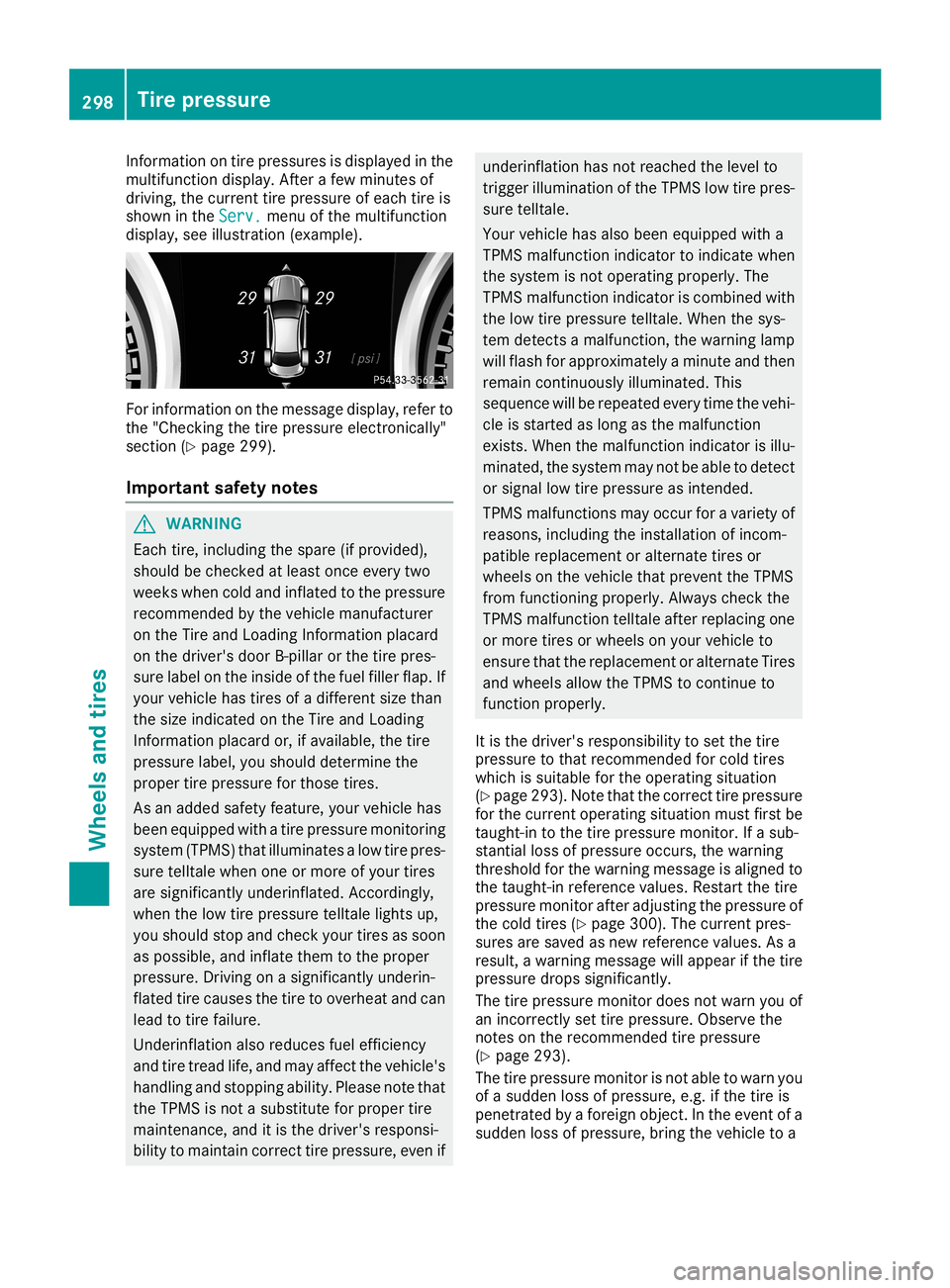
Information
ontire pressu resisdispl ayedin the
multifu nctiondisplay.After afew minutes of
driving, thecurrent tirepressu reofeach tireis
shown inthe Serv. Serv.
menuofthe multifu nction
displ ay,see illustration (example). For
information onthe message display,refer to
the "Checking thetire pressu reelectronical ly"
section (Ypage 299).
Important safetynotes G
WARNING
Each tire,includi ngthe spare (ifprovide d),
shoul dbe checked atlea stonce every two
weeks whencoldandinflated tothe pressu re
recommended bythe vehicle manufacture r
on the Tire andLoadi ngInformation placard
on the driver's doorB-pilla ror the tire pres-
sure labelon the inside ofthe fuel fillerflap. If
you rvehicle hastires ofadifferent sizethan
the size indicated onthe Tire andLoadi ng
Information placard or,ifavai lable,the tire
pressu relab el,you shoul ddetermine the
proper tirepressu refor those tires.
As anadde dsafety feature, yourvehicle has
been equipped withatire pressu remonitoring
system (TPMS)thatilluminates alow tirepres-
sure telltal ewhen oneormore ofyou rtires
are significa ntlyunderinfla ted.Accordingly,
when thelow tirepressu retelltal elights up,
you shoul dstop andcheck yourtires assoon
as possib le,and inflate themtothe proper
pressu re.Driving onasignifica ntlyunderin-
flated tirecause sthe tire tooverhea tand can
lea dto tire failure.
Underinfla tionalso reduces fuelefficiency
and tiretread life,and may affect thevehicle 's
handli ngand stopping ability. Plea senote that
the TPMS isnot asubstitu tefor proper tire
maintenance, anditis the driver's responsi-
bili tyto maintain correcttirepressu re,even if underinfla
tionhasnotreached thelevel to
trigger illuminatio nof the TPMS lowtirepres-
sure telltal e.
Your vehicle hasalso been equipped witha
TPMS malfunction indicator toindicate when
the system isnot opera tingproperl y.The
TPMS malfunction indicator iscombined with
the low tirepressu retelltal e.When thesys-
tem detects amalfu nction, thewarning lamp
wil lflash forappro ximately aminute andthen
remain continuously illuminated .This
sequ ence willbe repea tedevery timethevehi-
cle isstarted aslong asthe malfu nction
exists. Whenthemalfu nction indicator isillu-
minated, thesystem maynotbeabl eto detect
or signal lowtirepressu reas intended.
TPMS malfunctions mayoccur foravariety of
reasons, includingthe installa tionofincom-
patibl erepla cement oralternate tiresor
wheel son the vehicle thatprevent theTPMS
from functioning properly.Alway scheck the
TPMS malfunction telltaleafter replacingone
or more tiresorwheel son you rvehicle to
ensure thattherepla cement oralternate Tires
and wheel sall ow the TPMS tocontinue to
function properly.
It is the driver's responsib ility to set the tire
pressu reto that recommended forcold tires
which issuita bleforthe opera tingsitua tion
(Y page 293). Notethatthecorrect tirepressu re
for the current operatingsitua tionmust firstbe
taught-in tothe tire pressu remonitor. Ifasub-
stantial lossofpressu reoccurs, thewarning
threshold forthe warning messageis ali gned to
the taught-in reference values.Restart thetire
pressu remonitor afteradjusting thepressu reof
the cold tires (Ypage 300). Thecurrent pres-
sures aresaved asnew reference values.Asa
resul t,awarning messagewil lappe arifthe tire
pressu redrops significa ntly.
The tirepressu remonitor doesnotwarn youof
an incorrectly settire pressu re.Observe the
notes onthe recommended tirepressu re
(Y page 293).
The tirepressu remonitor isnot ableto warn you
of asudd enloss ofpressu re,e.g. ifthe tire is
penetrated byaforeign object.Inthe event ofa
sudd enloss ofpressu re,bring thevehicle toa 298
Tire
pressureWheel sand tires
Page 307 of 330

Observe
thelegal lyrequired minimum tiretread
depth (Ypage 291). Winter tirescanreduce the
braking distance onsnow-covered surfacesin
comparison withsummer tires.Thebraking dis-
tance isstill much further thanonsurfaces that
are not icyorcovered withsnow. Takeappro-
priate carewhen driving.
Further information onwinter tires(M+S tires)
(Y page 292).
Temper ature G
WARNING
The temperature gradeforthis tireisestab-
lished foratire that isproperly inflatedand
not overloaded .Exc essive speed, underinfla-
tion, orexcessive loading,either separately or
in combination, cancause excessive heat
buil d-up andpossible tirefailu re.
The temperature gradesareA(the highest), B,
and C,representing thetire's resistance tothe
generation ofheat anditsabil itytodissipa te
heat when tested undercontrolled conditions
on aspecified indoorlaboratorytestwheel. Sus-
tained hightemperature cancause thematerial
of the tire todegenerate andreduce tirelife, and
excessive temperature canlead tosudden tire
failu re.The grade Ccorresponds toalevel of
performance whichallpassenger cartires must
meet under theFederal MotorVehicle Safety
Standard No.109. Grades Band Arepresent
higher levelsofperformance onthe labora tory
test wheel thantheminimum requiredbylaw. Tire
labeli ng
Overview 0043
Uniform TireQuali tyGradi ngStandards
(Y page 309)
0044 Department ofTransportation, TireIdentifi-
cation Number (Ypage 308)
0087 Maximum loadrating (Ypage 307)
0085 Maximum tirepressures (Ypage 296)
0083 Manufacturer
0084 Tire material (Ypage 308)
006B Tire size designation, load-bearingcapacity
and speed rating(Ypage 305)
006C Load index (Ypage 307)
006D Tire name
The markings described aboveareonthe tire in
addition tothe tire name (sales designation) and
the manufacturer's name.
i Tire
data isvehicle-specific andmay deviate
from thedata inthe example.
Tire size designation, load-bearing
capacity andspeed rating G
WARNING
Exc eeding thestated tireload-bea ringcapa-
city and theapproved maximum speedcould
lead totire damage orthe tire bursting. There
is arisk ofaccident.
Therefore, onlyusetiretypes andsizes
approved foryour vehicle model.Observe the All
about wheelsand tires
305Wheels andtires
Z
Page 312 of 330
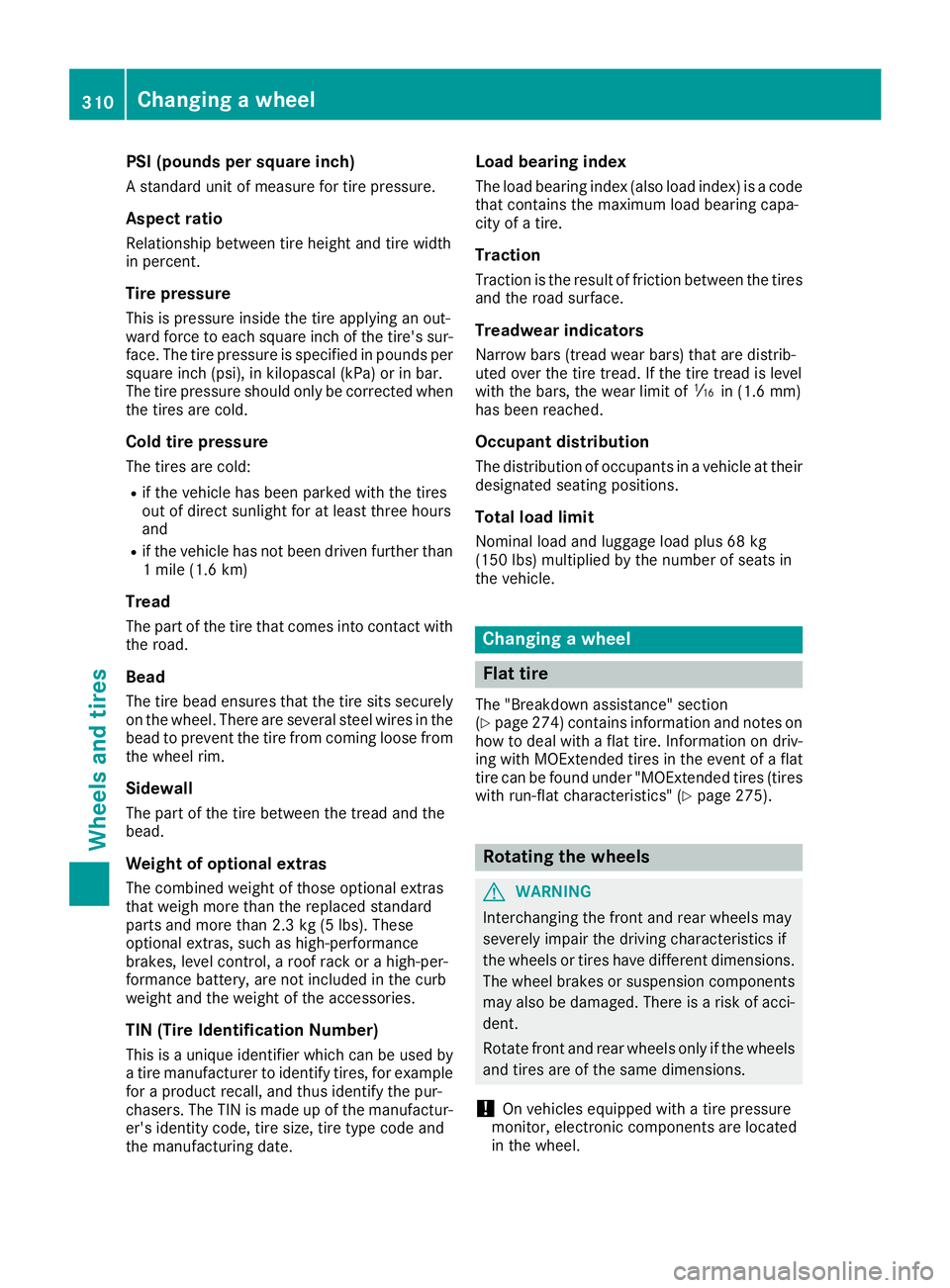
PSI
(pounds persquar einch)
A standard unitofmeasure fortire pressure.
Aspect ratio
Relationship betweentireheight andtirewidth
in percent .
Tire pressur e
This ispressure insidethetire apply inganout-
ward force toeach square inchofthe tire's sur-
face. Thetirepressure isspecified inpounds per
square inch(psi), inkilopascal (kPa)orinbar.
The tirepressure shouldonlybecorrect edwhen
the tires arecold.
Cold tirepressur e
The tires arecold:
R ifthe vehicle hasbeen parked withthetires
out ofdirect sunlight foratleast three hours
and
R ifthe vehicle hasnotbeen driven further than
1 mile (1.6km)
Tread
The part ofthe tire that comes intocont actwith
the road.
Bead The tirebead ensures thatthetire sits securely
on the wheel. Thereareseveral steelwires inthe
bead toprevent thetire from coming loosefrom
the wheel rim.
Sidewall The part ofthe tire between thetread andthe
bead.
Weight ofoptional extras
The combined weightofthose optional extras
that weigh morethanthereplaced standard
parts andmore than2.3kg(5lbs). These
optional extras,such ashigh-performanc e
brakes, levelcontrol,aroof rack orahigh-per-
formanc ebattery, arenot included inthe curb
weight andtheweight ofthe accessories.
TIN (Tire Identification Number)
This isaunique identifier whichcanbeused by
a tire manufacturer toidentify tires,forexample
for aproduct recall,andthus identify thepur-
chasers. TheTINismade upofthe manufactur-
er's identity code,tiresize, tiretype code and
the manufacturing date. Load
bearing index
The load bearing index(alsoloadindex) isacode
that contains themaximum loadbearing capa-
city ofatire.
Tra ction
Traction isthe result offrict ionbetween thetires
and theroad surface.
Tread wearindicators
Narrow bars(tread wearbars) thataredistrib-
uted overthetire tread. Ifthe tire tread islevel
with thebars, thewear limitof00CD in(1.6 mm)
has been reached.
Occupant distribution
The distribution ofoccupants inavehicle attheir
designated seatingpositions.
Total loadlimit
Nominal loadandluggage loadplus68kg
(15 0lbs )multiplied bythe number ofseats in
the vehicle. Changing
awheel Flat
tire
The "Breakdown assistance"section
(Y page 274)contains information andnotes on
how todeal with aflat tire. Inform ationondriv-
ing with MOExt ended tiresinthe event ofaflat
tire can befound under "MOExt endedtires(tires
with run-flat characterist ics"(Ypage 275). Rotat
ingthe wheels G
WARNING
Int erchanging thefront andrear wheels may
severely impairthedriving characterist icsif
the wheels ortires have different dimensions.
The wheel brakes orsuspension components
may alsobedamaged. Thereisarisk ofacci-
dent.
Rotate frontandrear wheels onlyifthe wheels
and tires areofthe same dimensions.
! On
vehicles equippedwith atire pressure
monitor ,electron iccomponen tsare located
in the wheel. 310
Changing
awheelWheels andtires
Page 314 of 330
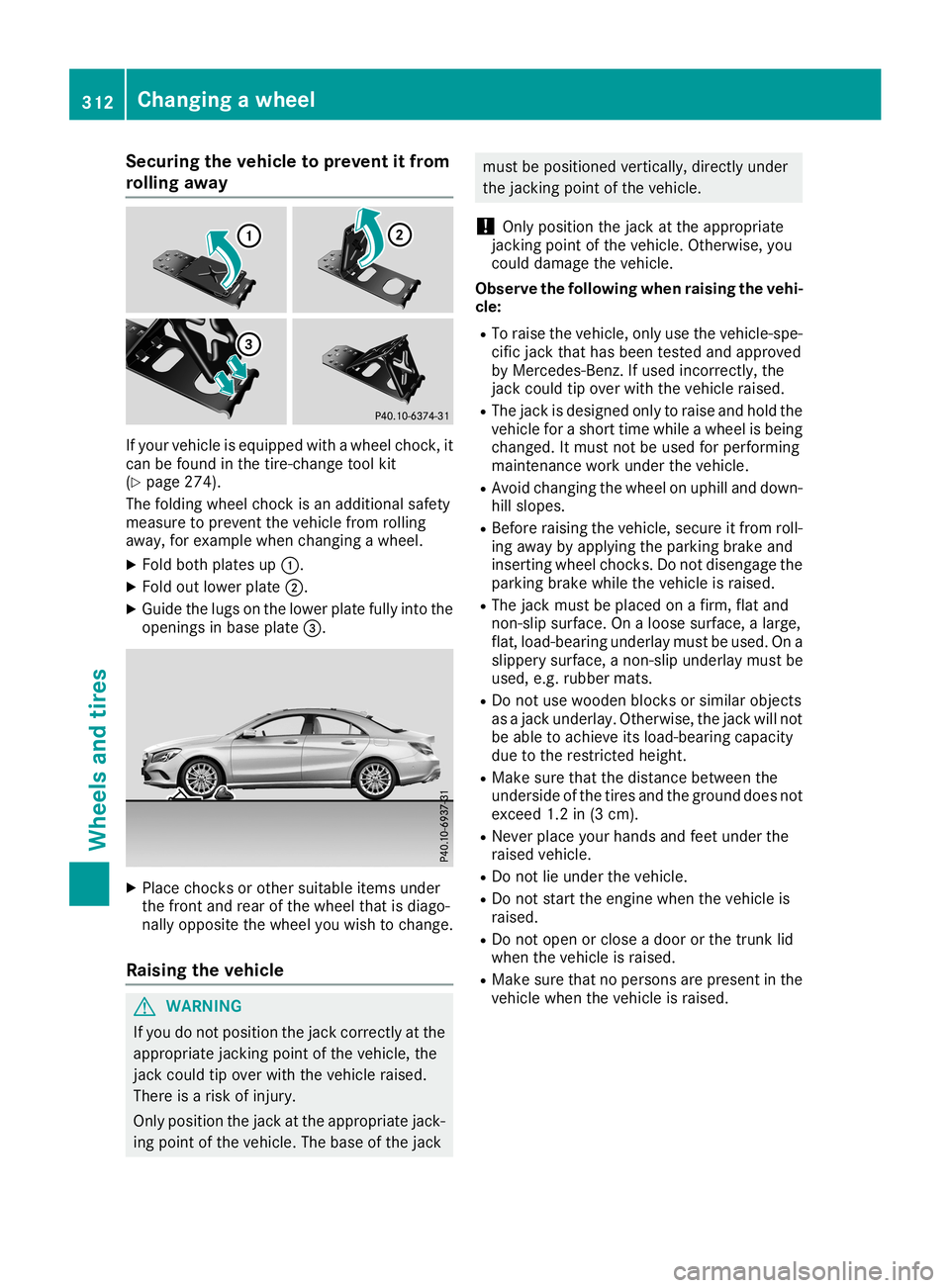
Securing
thevehicle toprevent itfrom
rolling away If
your vehicle isequippe dwith awheel chock,it
can befound inthe tire-c hange toolkit
(Y page 274).
The folding wheelchock isan additional safety
measure toprevent thevehicle fromrolling
away ,for example whenchanging awheel.
X Fold both plates up0043.
X Fold outlower plate0044.
X Guide thelugs onthe lower platefullyintothe
openings inbase plate 0087. X
Place chocksor other suitable itemsunder
the front andrear ofthe wheel thatisdiago-
nally opposite thewheel youwish tochange.
Raising thevehicle G
WARNING
If you donot position thejack correct lyat the
appropriate jackingpoint ofthe vehicle, the
jack could tipover withthevehicle raised.
There isarisk ofinjury.
Only position thejack atthe appropriate jack-
ing point ofthe vehicle. Thebase ofthe jack must
bepositioned vertically,directlyunder
the jackin gpoint ofthe vehicle.
! Only
position thejack atthe appropriate
jackin gpoint ofthe vehicle. Otherwise, you
could damage thevehicle.
Observe thefollow ingwhen raising thevehi-
cle:
R To raise thevehicle, onlyusethevehicle-spe-
cific jack thathasbeen tested andapproved
by Mercedes-B enz.Ifused incorrec tly,the
jack could tipover withthevehicle raised.
R The jack isdesigned onlytoraise andhold the
vehicle forashort timewhile awheel isbeing
changed. Itmust notbeused forperforming
maintenan cework under thevehicle.
R Avoid changing thewheel onuphill anddown-
hill slopes.
R Before raising thevehicle, secureitfrom roll-
ing away byapply ingthe parking brakeand
insertin gwheel chocks.Do not disengage the
parking brakewhilethevehicle israised.
R The jack must beplaced onafirm, flatand
non- slipsurface. Onaloose surface, alarge,
flat, load-bearing underlaymustbeused. Ona
slippery surface, anon- slipunderlay mustbe
used, e.g.rubber mats.
R Do not use wooden blocksorsimilar objects
as ajack underlay. Otherwise, thejack willnot
be able toachieve itsload-bearing capacity
due tothe restrict edheight.
R Make surethatthedistance between the
underside ofthe tires andtheground doesnot
exceed 1.2in(3 cm).
R Never placeyourhands andfeet under the
raised vehicle.
R Do not lieunder thevehicle.
R Do not start theengine whenthevehicle is
raised.
R Do not open orclose adoor orthe trunk lid
when thevehicle israised.
R Make surethatnopersons arepresent inthe
vehicle whenthevehicle israised. 312
Changing
awheelWheels andtires